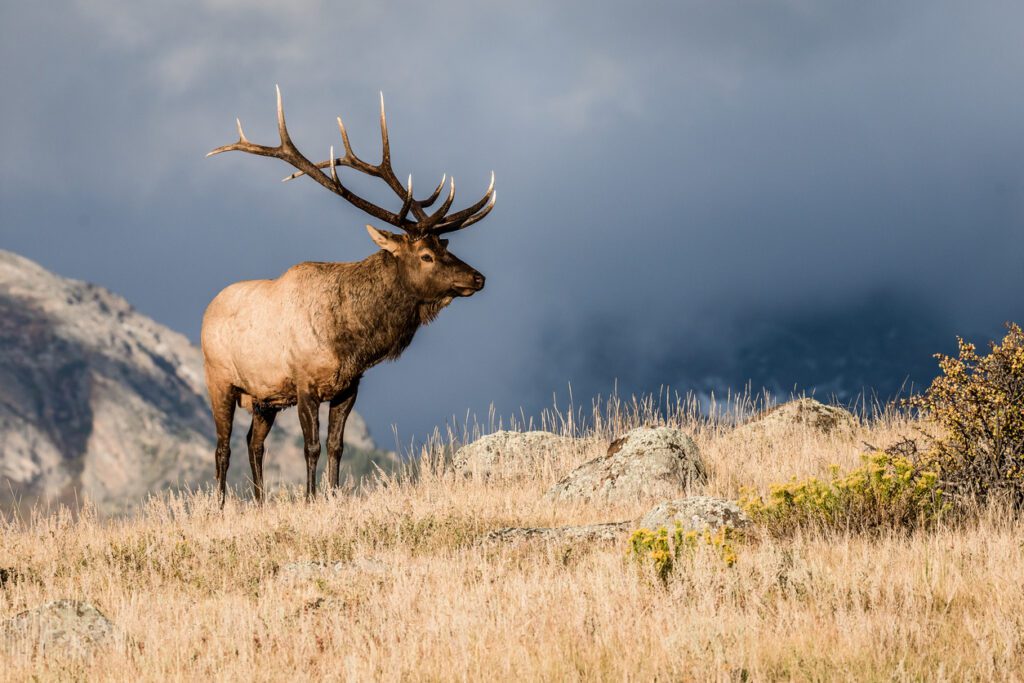Behold the Rocky Mountain Elk, scientifically known as Cervus elaphus nelsoni, an emblematic subspecies among the four that thrive in the vast expanse of the United States. In the heart of New Mexico, this majestic creature takes its place as the largest mammal. Revered as one of the most sought-after trophies for big game hunters, the presence of the Rocky Mountain Elk in New Mexico is the result of extensive efforts to reintroduce them to their native habitat after their extirpation in the early 1900s. Both the Rocky Mountain Elk and the now-extinct Merriam’s Elk (C. e. merriami) once roamed the state’s rugged mountainous terrains, and they held a sacred cultural significance for many southwestern tribes across the region. Merriam’s elk, in particular, were known to populate the southern mountains of both New Mexico and Arizona until the European settlers arrived, bringing unregulated hunting and the transformative presence of sheep and cattle, leading to their precipitous decline in the late 1800s. By 1900, elk were a rare sight in the southern mountains, and the last recorded elk in the northern part of the state was seen in 1909.
Shortly after the elk vanished from the state, the journey of reintroducing the species commenced in 1911. It was during this time that the Bartlett Ranch, also known as Vermejo Park, acquired 15 Rocky Mountain elk, while the state of New Mexico imported 12 elk from Colorado to reestablish small populations in the northern mountains. Subsequent reintroduction initiatives were undertaken after the passage of the Pittman Robertson Act in 1938. This legislation provided the state with funds derived from excise taxes on sporting equipment, such as firearms and ammunition. This act, still in force today, is a critical financial resource for state wildlife management agencies across the United States. Early funds were allocated to continue the reintroduction of elk into New Mexico, and between 1954 and 1967, the Department of Game and Fish, established in 1912, transplanted 638 elk into the state. Since then, elk have flourished in many of their historical ranges in the mountainous regions, and their population is estimated to range from 81,100 to 105,700 (according to 2018 data) across New Mexico.
THE ANIMAL
Elk, the second-largest members of the deer family, scientifically belong to the Cervidae group. Mature bulls exhibit an impressive weight range between 800 and 1,100 pounds, while adult cows weigh between 500 and 660 pounds. Their stature boasts a total body length of 80 to 100 inches and a front shoulder height that spans from 55 to 60 inches, making them an imposing presence second only to moose within the deer family. The Native American name for these elk, “Wapati,” is an ode to their distinctive “white rump.” Their coats typically showcase a tawny brown or light tan hue, accentuated by a mane of darker, longer hair that extends from the front shoulders onward. Antlers, a signature trait, are exclusive to male, or bull, elk. These antlers begin growing in late spring and continue to develop before shedding annually to be replaced. The antler development process commences in their first year and extends throughout their lifespan, with the maximum antler size typically observed in 7-8-year-old bulls. These antlers usually feature six tines each, spanning up to 40-45 inches in length and weighing 15-20 pounds apiece. Antler size can vary among individual bulls, influenced by factors such as age, the quality of spring forage, and nutritional condition at a young age. These formidable antlers play a pivotal role in establishing dominance during the rut, the breeding season, and also serve as a defense against predators. Elk exhibit varying lifespans, with cows generally living longer, around 15-18 years, compared to bulls, who typically have a lifespan of 10-13 years.
HABITAT
Elk in New Mexico have a strong association with forested mountain and foothill ecosystems, characterized by a blend of open meadows and sheltered terrain. They are commonly found in aspen and pine forests, as well as pinon and juniper uplands. Elk are strict herbivores, with their diet primarily consisting of grasses and forbs. Their foraging activities are most prevalent during the early morning and twilight hours in open meadows. During the daytime, they seek refuge in dense timber, resting in shaded, cool areas that shield them from midday temperatures and reduce their vulnerability to predators. In the northern parts of New Mexico, some elk partake in seasonal migrations, transitioning between high-elevation habitats in the summer and low-elevation habitats in the winter, when snow accumulates in the mountains, making foraging more challenging. The breeding season for elk occurs during the mid to late fall, with mature bull elk’s bugling calls echoing through the landscape and their distinctive antler-to-antler sparring bouts. These bouts serve to establish dominance within the herd and secure the opportunity to mate with a harem of breeding-age cow elk. Not every bull will have the chance to mate each year, and typically, one bull will breed with multiple cows. With the arrival of spring, newborn elk calves make their appearance. For most elk, peak calving occurs around June 1st when the spring vegetation is exceptionally nutritious. These newborn calves typically weigh between 30-35 pounds at birth and are characterized by speckled coats, serving as their primary camouflage and defense against predators during their first week of life. Common predators that pose a threat to elk calves include coyotes, black bears, and mountain lions.


